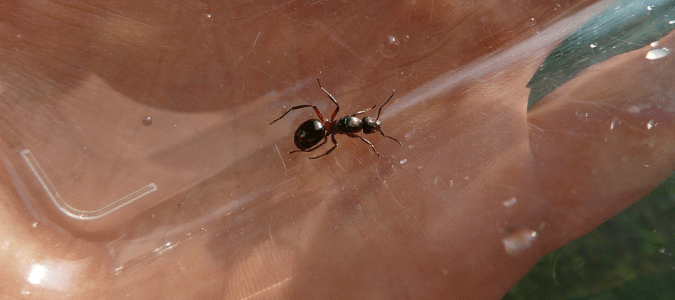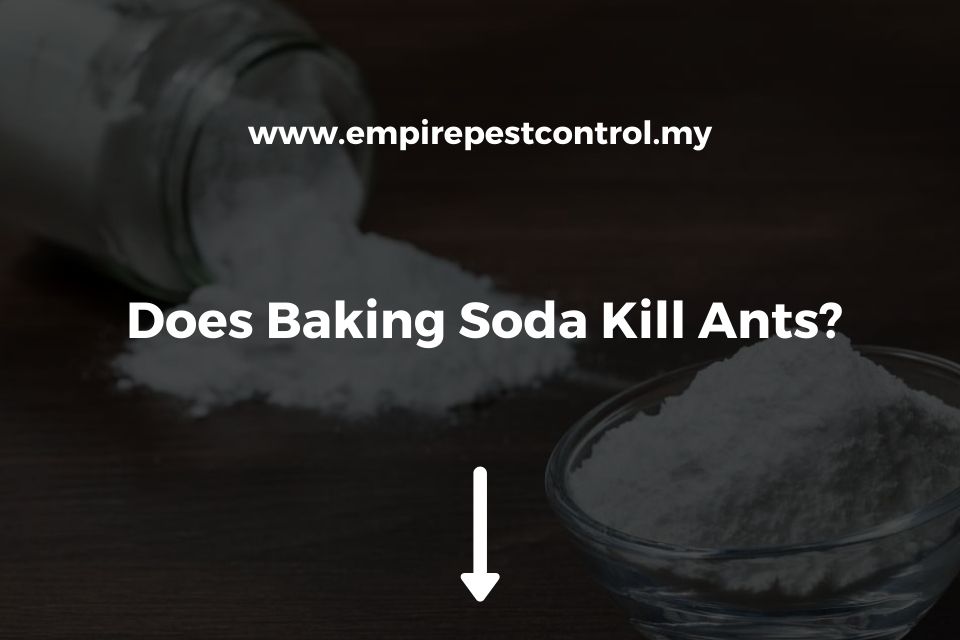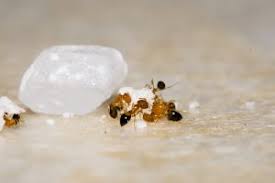When ants consume baking soda, it reacts with their acidic digestive system causing internal disruptions. This reaction can prove fatal to the ants.
Ants, constantly on the quest for food, may stumble upon baking soda, a common household item. While harmless to humans in small amounts, baking soda can be deadly to ants due to their unique physiology. The bicarbonate nature of the compound disrupts the ants’ internal acid-base balance, leading to dire consequences.
Enthusiastic gardeners and homeowners often turn to this natural remedy when facing an ant infestation. Offering an inexpensive and eco-friendly solution, baking soda sidesteps the drawbacks of chemical pesticides. As an easily accessible and effective approach, it has gained popularity in the battle against these resilient insects.
The Curious Case Of Ants And Baking Soda
Entomologists and DIY pest controllers alike buzz with fascination about the curious case of ants and baking soda. Why do these tiny critters meet their demise upon encountering a common kitchen staple? Let’s sprinkle some insight.
Ants’ Foraging Behavior
Ants constantly search for food, guided by their sense of smell. They prefer sweet or greasy substances, making kitchens prime targets. When ants discover a potential food source, they release pheromones, marking a trail for fellow colony members to follow, leading to an ant invasion.
- Scout ants explore and locate food sources.
- Worker ants follow trails and gather food.
- Food is shared among colony members, including baking soda if present.
Chemical Composition Of Baking Soda
Baking soda, or sodium bicarbonate, is a white crystalline powder. It’s known for its ability to neutralize acids and odors. Under certain conditions, it decomposes, releasing carbon dioxide gas.
| Component | Role |
|---|---|
NaHCO3 | Decomposes to produce CO2, which disrupts ant internal organs when ingested. |
| pH Level | Alkaline nature can be toxic to ants. |
When ants ingest baking soda, their bodies can’t handle the chemical reaction. This leads to an accumulation of carbon dioxide, causing internal damage and eventual death. This is why sprinkling baking soda around ant-infested areas can act as a non-toxic pest control method.

Credit: www.abchomeandcommercial.com
Baking Soda: A Household Item With Hidden Effects
Baking soda, often found in kitchen pantries, emerges as a surprise warrior against ant invasions. While known for its versatility in cooking and cleaning, its interaction with ants reveals a lethal side. Delve into its common uses and its lesser-known toxic effects on insects. Unveil how this white powder can impact the natural world around your home.
Common Uses Of Baking Soda
- Deodorizer: Neutralizes odors in fridges and carpets.
- Cleaning Agent: Cleans surfaces without harsh chemicals.
- Cooking: Acts as a leavening agent in baking.
- Personal Care: Used in homemade toothpaste and deodorant.
- Health: Eases heartburn by neutralizing stomach acid.
Baking Soda’s Toxicity To Insects
Baking soda shows a dark side when it comes to bugs. Its toxicity to ants creates a doomspell for these tiny invaders. When ants ingest baking soda, a reaction occurs in their bodies. They do not have the proper acid to neutralize this substance like humans do.
| Effect | Description |
|---|---|
| Reaction Inside Ants | Baking soda mixes with ant stomach acid, releasing carbon dioxide. |
| Physical Distress | Ants can’t expel the gas, leading to internal pressure and death. |
Watch as your kitchen remedy turns into an invisible shield against pests. The lethal outcome for ants might go unnoticed, but the efficacy speaks volumes. Baking soda, beyond its daily uses, stands as a simple yet potent insect deterrent.
An Unexpected Reaction
An Unexpected Reaction occurs when ants encounter baking soda, a common household substance many might not consider as an insect deterrent. While ants are incredibly resourceful creatures, their physical structures and digestive processes are not equipped to handle the compound found in this simple pantry staple.
How Ants Digest Baking Soda
Ants have a unique digestive system that differs significantly from humans. When ants ingest baking soda, they cannot process the compound like we do.
- Baking soda is a bicarbonate (NaHCO3).
- Ants lack the proper acid to break down this substance.
- Their stomachs contain formic acid, which reacts with the baking soda.
The Science Behind The Reaction
The science behind the reaction between ants and baking soda lies in chemistry. Here’s what happens on a molecular level:
| Component | Role | Result |
|---|---|---|
| Baking Soda (NaHCO3) | Consumed by ants | Reacts with formic acid |
| Formic Acid | Found in ant’s stomach | Produces carbon dioxide gas |
| Carbon Dioxide (CO2) | Byproduct of reaction | Builds up and causes internal pressure |
The buildup of CO2 creates pressure that can be detrimental to the ant’s internal system, leading to its eventual demise.
Mortal Meals: The Impact On Ant Physiology
Understanding how ants react to baking soda uncovers intriguing aspects of their biology. Baking soda, a harmless kitchen ingredient for humans, turns lethal when ingested by ants. This phenomenon raises curiosity about its physiological effects on these tiny insects. Here’s a closer look at how a simple substance can significantly impact ant health and survival.
Physical Effects On Ants
Ants, renowned for their intricate social systems, encounter severe physical challenges after consuming baking soda. Unlike humans, ants cannot expel gas, leading to internal complications. Observations reveal several physical repercussions:
- Disruption of digestive functions due to the inability to neutralize the baking soda’s bicarbonate component.
- Expansion of internal gases causing discomfort and potential internal damage.
- Breakdown of the ant’s internal equilibrium, often resulting in fatal outcomes.
The Role Of Carbon Dioxide
When ants consume baking soda and it combines with their acidic stomach fluids, carbon dioxide is generated. Baking soda’s chemical reaction plays a pivotal role:
| Reaction Component | Effect on Ant Physiology |
|---|---|
| Baking soda (sodium bicarbonate) | Interacts with acid in the ant’s stomach |
| Production of Carbon dioxide | Limits oxygen flow and leads to internal pressure build-up |
| Pressure build-up | Proves incompatible with ant biology, causing death |
Increased carbon dioxide levels within the ant cause a cascade of physiological disruptions. This leads to an inability to absorb nutrients and ultimately results in mortality.
Observations Of Ant Behavior Post Ingestion
Many find the sight of ants marching in a line quite fascinating. But what happens when they come across baking soda, a common household item? Our exploration into the aftermath of ants eating baking soda reveals some intriguing behaviors.
Immediate Reactions Of Ants
Upon ingesting baking soda, ants exhibit a range of immediate reactions. Observations show that ants’ movements become erratic. They may pause frequently and seem disoriented. Some ants even stop moving completely as if overwhelmed by the substance.
- Erratic walking
- Sudden pausing and disorientation
- Ants may cease movement
Long-term Effects On The Colony
The long-term impacts on the ant colony can be significant. Baking soda intake disrupts an ant’s internal pH balance, leading to death. This impact is not immediate but it affects the colony’s health gradually. Here’s how:
| Timeframe | Effect on Ant Colony |
|---|---|
| Short-term | Ants die, reducing the colony’s foraging capability |
| Mid-term | Worker ant population diminishes; impacts resources gathering |
| Long-term | Colony’s growth stalls; risk of colony collapse increases |

Credit: www.empirepestcontrol.my
The Chain Reaction In An Ant Colony
Imagine a bustling ant colony, a superb example of organization and teamwork. What happens when you introduce baking soda into this equation? A fascinating chain reaction unfolds, affecting each aspect of the ant world.
Implications For Ant Communication
Ants communicate using pheromones, chemical signals that guide others to food or alert them to danger. When ants ingest baking soda, their ability to produce and perceive these crucial signals diminishes. This disruption has several critical outcomes:
- Foraging patterns change, as ants can’t signal food locations effectively.
- Response to threats weakens, potentially exposing the colony to predators.
- Navigation becomes confused, leading ants astray from their defined paths.
Ant communication is the glue holding the colony together. Interfering with it sends ripples through their structured existence.
Disruption Of The Colony’s Dynamics
Ants operate on a strict hierarchy, with each ant playing a critical role. Baking soda ingestion, however, can cause chaos within this system:
- Worker ants struggle with their daily tasks, impacting the colony’s maintenance and food collection.
- Carers of larvae are affected, potentially reducing the colony’s growth rate.
- The queen’s welfare may be jeopardized, threatening the colony’s future.
These factors contribute to destabilizing the colony, highlighting the delicate balance of an ant ecosystem.
Utilizing Baking Soda As An Ant Control Method
Baking soda, a common kitchen ingredient, emerges as a clever solution against ant invasions. When ants consume the substance, it reacts with their acidic digestive system leading to internal chaos. This simple, non-toxic method creates an eco-friendly and cost-effective ant control strategy. A DIY approach with baking soda can keep your home ant-free.
Diy Ant Baits
Create your own ant baits using a mix of baking soda and powdered sugar. The sugar attracts ants, while the baking soda will be the key ingredient.
- Combine equal parts of both.
- Place the mixture near ant trails.
- Refill the baits regularly.
Considerations For Effective Ant Control
Effective ant control with baking soda requires strategy.
- Identify ant species for tailored solutions.
- Locate and target nests directly if possible.
- Avoid water as it dilutes the bait’s effectiveness.
- Keep the area clean to prevent other food sources.
Cautions And Environmental Considerations
Cautions and Environmental Considerations are crucial when using home remedies like baking soda to control ant populations. While it’s effective, the unintended consequences on the environment and non-target species should not be ignored. Mindful application ensures a balanced approach to pest management and ecosystem health.
Potential Effects On Non-target Species
Using baking soda as an ant deterrent carries the risk of affecting other creatures.
- Harmful to beneficial insects: Baking soda may inadvertently harm bees or ladybugs.
- Impact on pets: If ingested by pets, it may cause discomfort or illness.
- Risk to wildlife: Small mammals and birds might also suffer negative side effects.
Balancing Home Remedies And Ecosystem Health
Careful use of baking soda is key to protecting our environment while managing pests.
- Limit use: Only apply it in areas where ant activity is high.
- Targeted application: Spot treatment reduces exposure to other species.
- Consider alternatives: Research non-toxic options that are eco-friendly.
Beyond The Kitchen: A Look Into Future Research
Beyond the Kitchen: A Look into Future Research is a fascinating realm where everyday substances like baking soda are scrutinized for their complex effects. Baking soda, known for its role in culinary arts and cleaning, also garners scientific curiosity when it interacts with ants. The focus now shifts from the kitchen to the lab, where answers to intriguing questions beckon.
Scientific Interest In Baking Soda And Ants
Why do scientists care about ants and baking soda? The answer lies in the seemingly simple reactions that unfold. Ants have complex digestive systems, yet a common kitchen staple like baking soda disrupts their physiology.
Studies show that when ants ingest baking soda, it reacts with the acidic substances in their stomachs. This leads to a build-up of carbon dioxide gas, which ants can’t expel efficiently, resulting in distress and often fatality.
These insights propel researchers to delve into the microscopic interactions between ants and various substances. It’s imperative to understand how these small changes can have broader ecological impacts.
Potential For New Pest Control Innovations
The interaction between baking soda and ants doesn’t just pique scientific interest; it also offers a glimpse into potential pest control solutions. Innovations rooted in harmless, non-toxic substances are on the rise.
Experts are exploring baking soda’s efficacy in managing ant populations without resorting to harsh chemicals. This could revolutionize pest control strategies in homes and agriculture.
Future research might unveil:
- New application methods for baking soda in various environments.
- Combinations with other substances for enhanced effects.
- Specific ant species’ reactions to formulate targeted approaches.
As curiosity drives scientists, safer and more sustainable pest management tools could emerge, benefiting both human health and the environment.

Credit: www.facebook.com
Frequently Asked Questions Of What Happens When Ants Eat Baking Soda
Is Baking Soda Toxic To Ants?
Baking soda can be toxic to ants. When ants ingest baking soda, it reacts with their acidic digestive system causing internal damage or death. This property makes it a common home remedy for ant control.
What Happens To Ants After Eating Baking Soda?
After ants consume baking soda, it leads to a reaction with their stomach acid, producing carbon dioxide gas. This process can cause internal disruptions or even fatalities, as ants lack the ability to expel the gas efficiently.
How Does Baking Soda Affect Ant Colonies?
Baking soda affects ant colonies by eliminating worker ants that ingest it. As worker ants die off, the colony’s ability to feed and maintain itself is disrupted, potentially leading to the colony’s eventual collapse.
Can Baking Soda Be Used As An Ant Repellent?
Baking soda alone isn’t a repellent, but when mixed with powdered sugar, it attracts ants before the toxic effect takes place. This homemade mixture can help deter ants by reducing their numbers over time.
Conclusion
Feeding ants baking soda reveals much about their dietary reactions. The mix reacts with their stomach acids, leading to internal distress and often death. This information aids both in pest control and ecological studies. Understanding these impacts ensures better ant management and respect for their role in nature.
Remember, knowledge promotes coexistence.

I’m MD Tanvir, and I bring years of expertise gained from working closely with pest control companies to the forefront. My journey in the industry has inspired me to launch Bug Battler, a platform aimed at equipping people with the know-how to combat pests autonomously. Through Bug Battler, I aim to empower individuals with practical insights to tackle pest infestations effectively.

